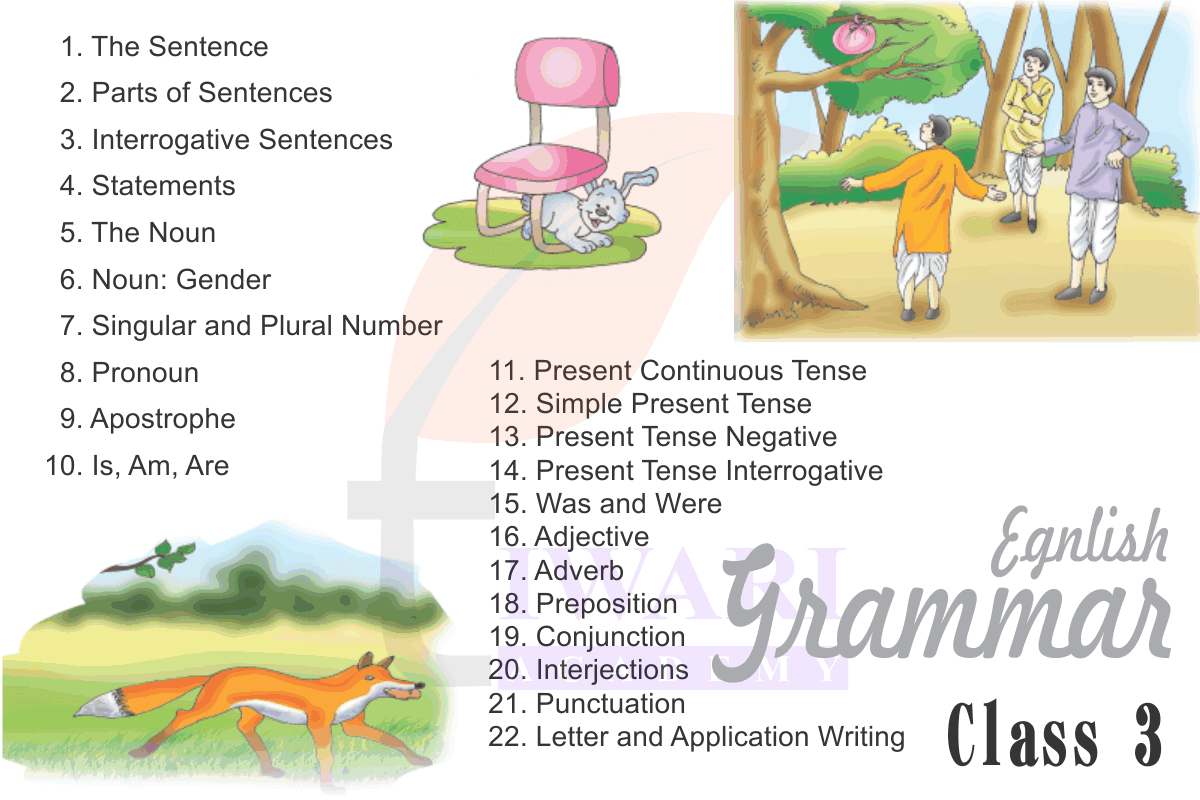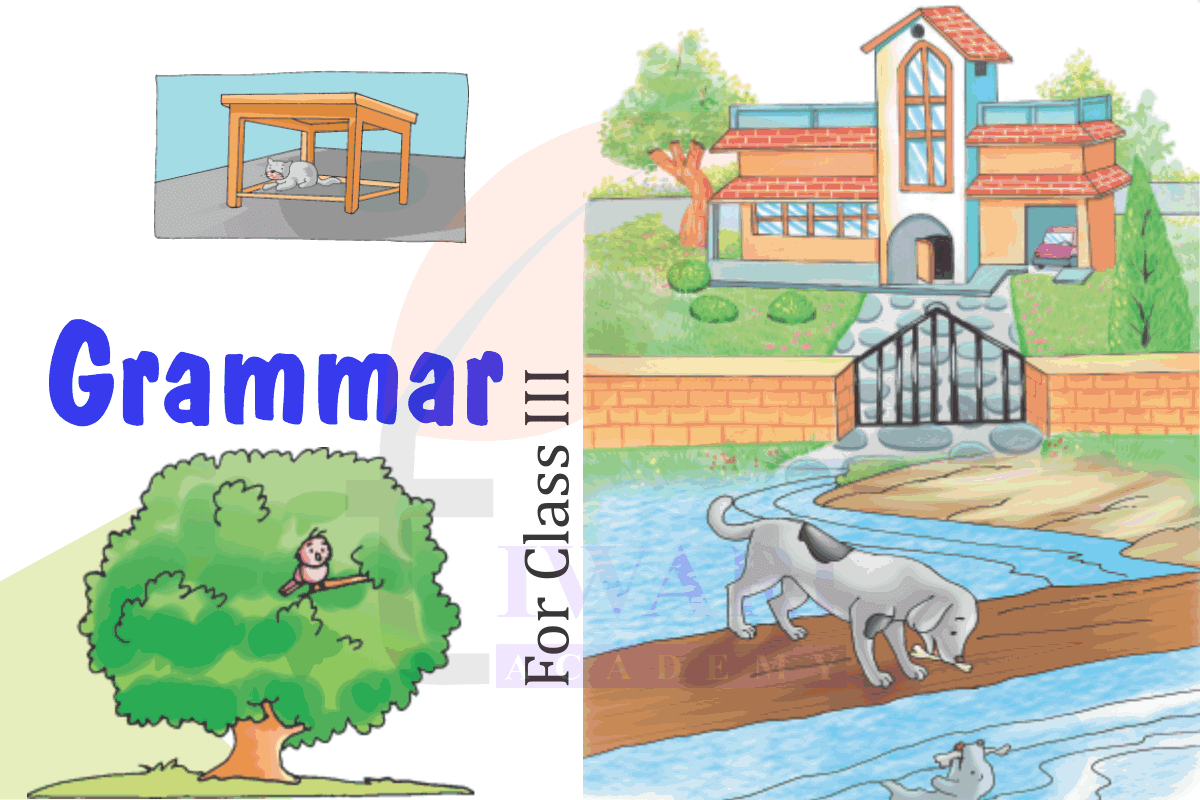Class 3 English Grammar all topics based on latest CBSE syllabus 2025-26 updated for new academic session free to use online or download in PDF file format. In Class 3 Grammar section, we will study about sentences, and its parts, Noun – Gender, Singular Plural, Pronoun, Apostrophe, Sentences using simple present tense, Adjectives, Adverbs, and some other topics which are important for Grade 3 students.
Study Tips for Class 3 Exam
Class 3 English Grammar Chapters
Chapter 1. The Sentence
Chapter 2. Parts of Sentences
Chapter 3. Interrogative Sentences
Chapter 4. Statements
Chapter 5. The Noun
Chapter 6. Noun: Gender
Chapter 7. Singular and Plural Number
Chapter 8. Pronoun
Chapter 9. Apostrophe
Chapter 10. Is, Am, Are
Chapter 11. Present Continuous Tense
Chapter 12. Simple Present Tense
Chapter 13. Present Tense Negative
Chapter 14. Present Tense Interrogative
Chapter 15. Was and Were
Chapter 16. Adjective
Chapter 17. Adverb
Chapter 18. Preposition
Chapter 19. Conjunction
Chapter 20. Interjections
Chapter 21. Punctuation
Chapter 22. Letter and Application Writing
If study materials include diagrams, charts, or illustrations, reviews can suggest improvements to these visual aids to make complex concepts more understandable. Your Review and Feedback can improve the quality of content. So, rate our contents provided here.
Tiwari Academy, being a renowned educational platforms, offers a comprehensive curriculum for Class 3 English Grammar. This means that all essential topics suitable for that grade 3, such as advanced sentence structures, parts of speech like adverbs and conjunctions, and foundational writing skills, are covered. The content is usually structured in a progressive manner, building upon what students have learned in previous grades and preparing them for more advanced topics in subsequent grades. Reviewers can assess whether the pedagogical approach (teaching methods) employed in the study material is effective for the intended audience and make recommendations for improvement.
Class 3 English Grammar for Session 2025-26
Modern educational platforms Tiwari Academy emphasize the importance of interactive learning, especially for younger students. Tiwari Academy’s website and apps incorporates multimedia elements, quizzes, interactive exercises, and real-life examples to make grammar more relatable and engaging for Class 3 students. These methods not only make learning enjoyable but also enhance retention and application of grammatical rules.
Quality educational platforms prioritize clarity in their content. The explanations provided for grammatical concepts at Tiwari Academy are concise, clear, and free from jargon. Furthermore, Tiwari Academy employ a multi-pronged approach to teaching, catering to the varied learning styles of students. This include textual explanations, illustrative examples, video lessons, and practice exercises. Such a holistic approach ensures that every student, regardless of their learning preference, can grasp and master the concepts presented. To get a more accurate assessment, it’s best to review the content offered by Tiwari Academy directly or consult reviews and feedback from students and educators familiar with their materials.
Class 3 English Grammar builds on the foundational concepts introduced in the earlier grades while introducing students to more nuanced elements of the language. The goal at class 3 stage is to solidify the basics and gradually pave the way for advanced learning in subsequent grades.
| Class: 3 | English Grammar |
| Contents: | Explanation and Assignments |
By Class 3 grammar, students are expected to construct clear and coherent sentences. They delve deeper into the subject-verb agreement and learn about different types of sentences based on their structure (simple, compound) and their purpose (declarative, interrogative, exclamatory, and imperative). A significant focus is also placed on tenses. Students of grade 3, are introduced to the basic tenses – present, past, and future – and their various forms like simple, continuous, and perfect, helping them indicate the timing of actions accurately.
While nouns, pronouns, verbs, and adjectives might already be familiar from previous grades, Class 3 typically dives deeper into these areas. Adverbs, which describe verbs, are introduced, and students learn about their different types and placements in sentences. Conjunctions, which link words or sentences, become another focal point. The concepts of articles (a, an, and the) are solidified. There’s also a focus on understanding the difference between common and proper nouns, singular and plural forms, and regular and irregular verbs.
Class 3 English Grammar Main Points in Syllabus
The Sentences
In class 3 English Grammar, we understand about sentences. Sentence is a group of words contain a proper meaning. Basically in a sentence there should be a subject and object and to join them one linking or helping verb. There are many types of sentences like: simple sentence, mix sentence, complex sentence etc.
Proper punctuation becomes pivotal in Class 3. Students learn the importance of using commas, apostrophes, quotation marks, and other punctuation symbols to provide clarity to their sentences. Vocabulary expansion is also stressed upon. Through reading exercises, spelling bees, or vocabulary quizzes, students are encouraged to learn new words and use them in context. This not only enhances their writing but also boosts their comprehension skills when reading.

Class 3 English Grammar serves as a bridge between basic foundational concepts and more advanced linguistic structures. While all topics in the curriculum are essential for holistic language development, three topics stand out in terms of their significance and foundational importance. In all these areas, the emphasis remains on practical application, ensuring students not only understand the rules but can also use them effectively in everyday communication.
Parts of Sentences
In this chapter we understand about parts of a sentence. A sentence has mainly two parts, one is subject and another is predicate. Subject is the part of sentence about which we describe and in predicate what we describe about a person or thing. A subject may be noun or pronoun and predicate contain verb, adjective, adverb etc.
Interrogative Sentences
In this chapter we learn making of interrogative sentences. Interrogative means asking question. In interrogative sentences we ask question about a person, a place or thing. To change a simple sentence into interrogative sentence we make some changes like, start sentence with helping verb or use some special words like what, when, where etc. An interrogative sentence always ended with sign of interrogation (?).
One of the cornerstones of Class 3 grammar is an in-depth understanding of sentence structure. At this stage, students move beyond merely constructing simple sentences to formulating more complex ones. They learn to differentiate between various types of sentences based on their structure and purpose. Alongside, the introduction and understanding of tenses become pivotal. Grasping the concept of tenses be it past, present, or future is crucial as it enables students to accurately indicate the timing of actions. Understanding how to conjugate verbs according to different tenses and use them correctly in sentences is fundamental for clear and effective communication.
Statements and their types
This chapter of grammar tell us about different type of statements. A statement may be positive or we may say simple, another one is negative and sometime it is interrogative in nature where we ask question. We can change positive statement in to negative or interrogative statement by adding some extra words like no, not, what, when etc.
The noun
In this chapter we learn about noun. Noun is a part of a sentence, it may be the name of a person, name of a place or name of a thing. There are different types of noun, here we learn about them. Proper noun used for particular person. If we see a collection of things we can use collective noun.
While students in previous grades might have been introduced to basic parts of speech like nouns, pronouns, verbs, and adjectives, Class 3 takes a step ahead in learning grammar. The introduction of adverbs, which modify or describe verbs, and conjunctions, which help connect words or sentences, play a significant role in enhancing the complexity and richness of a student’s expression. Furthermore, a thorough grasp of these parts of speech ensures that students can form and interpret sentences with clarity, setting a solid foundation for more advanced linguistic topics in the future.

Noun: Gender
Here student learn about gender of a noun. The gender related to noun these are mainly four types. The gender of a noun means it belongs to masculine gender, feminine gender, common gender or a neuter gender.
Noun: Singular and Plural number
In this chapter we practice number of a countable noun. Mainly there are two forms one is singular and another is plural form. To change a singular noun in to plural form we add some extra letter to the singular noun like ‘s’ and ‘es’ etc. we also learn about some countable nouns which have same form in singular and plural form.
Punctuation goes beyond just placing symbols in sentences; it provides clarity, structure, and meaning. In Class 3 English Grammar, students learn the nuances of various punctuation marks, such as the use of commas to separate items in a list, apostrophes to indicate possession, or quotation marks to highlight direct speech.
Proper punctuation is paramount as it prevents ambiguity, ensuring that the reader interprets the sentence as the writer intended. While these topics are undeniably crucial, it’s essential to remember that English grammar is interwoven, with each topic building upon another. Hence, a balanced approach to all areas ensures comprehensive language proficiency.
Pronoun
In this chapter we learn about pronouns. Pronouns are the words used instead of noun. A pronoun can do all the things which a noun can do.
Apostrophe (‘s)
In this chapter we read about use of ‘s (Apostrophe). It is to show singular possession. This means a person own a product, an idea or an emotion.
Is, Am, Are
We know two types of verb one is main verb and another is helping verb or linking verb. Here in this chapter we learn about helping verb. According tenses these are different, in present tense we use is, am and are.
Present Continuous Tense (Is/Am/Are + verb + ing)
This chapter describe about the sentences of present continuous tense. To make a present continuous sentence we use ‘ing’ form of a verb. This tense tell us about the continuity of action.

